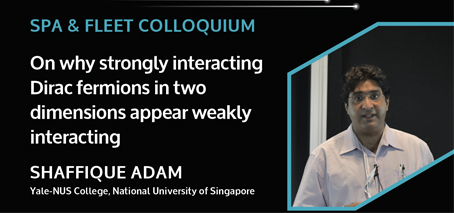-
1 Aug 2018
2:00 pm - 3:00 pm
Why do strongly interacting Dirac fermions in two-dimensions appear weakly interacting?
Shaffique Adam
Yale – National University of Singapore College
All welcome! The seminar flyer can be downloaded here.
About the Speaker:
Shaffique Adam is currently a Associate Professor of Yale-NUS College, a Singaporean National Research Foundation Fellow and also FLEET’s associate investigator. A/Prof Adam is an expert in the theoretical physics of Dirac systems. Within FLEET, he is working on gaining an understanding of the electronic transport and other properties of novel Dirac semimetals, as well as the conventional insulator to topological insulator transition in such systems. View his Research webpage.
Abstract:
Condensed matter realizations of twodimensional Dirac fermions were once a theoretical novelty. Today, they are ubiquitous. I will begin by providing a general overview of various material systems that host Dirac fermions, with a particular focus on single monoatomic sheets of carbon called graphene – an electronic material that was isolated about ten years ago, and notable not only for its ease of preparation and theoretical simplicity, but also for its promise as future electronic devices.
Treating the electrons in graphene as weakly interacting massless Dirac fermions was met with strong validation from experiments, and in many ways, graphene became a textbook system to test some foundational ideas in condensed matter physics. However, graphene was always expected to be a strongly interacting electronic system, and the scarcity of any observations that could be definitively attributed to correlation physics was mysterious.
In this talk, I will focus on some of our most recent theoretical results where we use a combination of nonperturbative numerical and analytical techniques that incorporate both the contact and long-range parts
of the Coulomb interaction. Within this framework, we will discuss applications of the theory to several open questions.
Venue: Seminar Room 107, School of Physics and Astronomy
Address:

